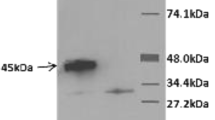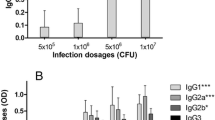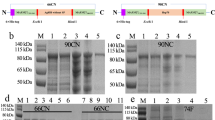Abstract
The PhoP-PhoQ two-component system of Yersinia pseudotuberculosis, a Gram-negative enteric pathogen which causes a variety of gastrointestinal and extraintestinal infections in humans, has been shown to be necessary for virulence. A phoP-phoQ null mutant of a strain of Y. pseudotuberculosis cured of its native plasmid pYV was obtained and studied for generation of immune response in mouse model following intravenous inoculation. The phoP-phoQ null mutant elicited much weaker IgG antibody response to whole cell sonicated (WCS) antigen, in particular that of IgG2a isotype. Interferon-γ levels were also significantly reduced in cultured splenocytes of mice immunized with phoP-phoQ null mutant. The null mutant was found to be about 72-fold less virulent than the parent isogenic strain of Y. pseudotuberculosis. Average counts in spleen of mice inoculated with the null mutant were observed to reduce by at least four logs when compared with the counts in the spleen of mice inoculated with parent isogenic strain. We can thus suggest that the Th1-type immune response of the phoP-phoQ null mutant of Y. pseudotuberculosis is diminished in mice.






Similar content being viewed by others
Abbreviations
- CFU:
-
Colony-forming units
- ELISA:
-
Enzyme-linked immunosorbent assay
- LFR:
-
Long flanking region
- LD50 :
-
Lethal dose 50
- PBS:
-
Phosphate buffer saline
- YOPs:
-
Yersinia outer proteins
- WCS:
-
Whole cell sonicated
References
Bogdanovich T, Carniel E, Fukushima H, Skurnik M (2003) Use of O-antigen gene cluster- specific PCRs for the identification and O-genotyping of Yersinia pseudotuberculosis and Yersinia pestis. J Clin Microbiol 11:5103–5112. doi:10.1128/JCM.41.11.5103-5112.2003
Bohn E, Autenrieth IB (2004) Immune response to Yersinia. In: Carniel E, Hinnebusch JB (eds) Yersinia molecular and cellular biology. Horizon Biosciences, Norfolk, pp 169–191
Butler T (1994) Yersinia infections: centennial of the discovery of the plague bacillus. Clin Infect Dis 19:655–661
Carniel E (2001) The Yersinia high-pathogenicity island: an iron uptake island. Microbes Infect 3:561–569. doi:10.1016/S1286-4579(01)01412-5
Conchas RF, Carniel E (1990) A highly efficient electroporation system for transformation of Yersinia. Gene 87:133–137. doi:10.1016/0378-1119(90)90505-L
Derbise A, Lesic B, Dacheux D, Ghigo JM, Carniel E (2003) A rapid and simple method for inactivating chromosomal genes in Yersinia. FEMS Immunol Med Microbiol 38:113–116. doi:10.1016/S0928-8244(03)00181-0
Flamez C, Ricard I, Arafah S, Simonet M, Marceau M (2008) Phenotypic analysis of Yersinia pseudotuberculosis 32777 response regulator mutants: new insight into two component system regulon plasticity in bacteria. Int J Med Microbiol 298:193–207. doi:10.1016/j.ijmm.2007.05.005
Gemski P, Lazere JR, Casey T, Wohlhieter JA (1980) Presence of a virulence- associated plasmid in Yersinia pseudotuberculosis. Infect Immun 28:1044–1047
Grabenstein JP, Marceau M, Pujol C, Simonet M, Bliska JB (2004) The response regulator PhoP of Yersinia pseudotuberculosis is important for replication in macrophages and for virulence. Infect Immun 72:4973–4984. doi:10.1128/IAI.72.9.4973-4984.2004
Grabenstein JP, Fukuto HS, Palmer LE, Bliska JB (2006) Characterization of phagosome trafficking and identification of PhoP regulated genes important for survival of Yersinia pestis in macrophages. Infect Immun 74:3727–3741. doi:10.1128/IAI.00255-06
Kado CI, Liu S-T (1981) Rapid procedure for detection and isolation of large and small plasmids. J Bacteriol 145:1365–1373
Khushiramani R, Tuteja U, Shukla J, Panikkar A, Batra HV (2006) Virulence markers of LCR plasmid in Indian isolates of Yersinia pestis. APMIS 114:15–22. doi:10.1111/j.1600-0463.2006.apm_254.x
Kumar S, Ray P, Singh H, Ganguly NK (2001) Immunogenicity and protective role of an IgA reactive 31 kDa antigen of Vibrio cholerae O139. J Med Microbiol 50:489–498
Ljungberg P, Valtonen M, Harjola VP, Kaukoran Tatolvanen SS, Vaara M (1995) Report of four cases of Yersinia pseudotuberculosis septicaemia and a literature review. Eur J Clin Microbiol Infect Dis 14:804–810. doi:10.1007/BF01690998
Logsdon LK, Mecsas J (2003) Requirement of Y. pseudotuberculosis effectors YopH and YopE in colonization and persistence in intestinal and lymph tissues. Infect Immun 71:4595–4607. doi:10.1128/IAI.71.8.4595-4607.2003
Miller SI, Mekalanos JJ (1990) Constitutive expression of phoP regulon attenuates Salmonella virulence and survival within macrophages. J Bacteriol 172:2485–2490
Oyston PC, Dorrell N, Williams K, Li S-R, Green M, Titball RW, Wren BW (2000) The response regulator phoP is important for survival under conditions of macrophage-induced stress and virulence in Yersinia pestis. Infect Immun 68:3419–3425. doi:10.1128/IAI.68.6.3419-3425.2000
Paff JR, Triplett DA, Saari TN (1976) Clinical and laboratory aspects of Yersinia pseudotuberculosis infections, with a report of two cases. Am J Clin Pathol 66:101–110
Portnoy DA, Falkow S (1981) Virulence associated plasmids from Yersinia enterocolitica and Yersinia pestis. J Bacteriol 148:877–883
Reed LJ, Muench H (1938) A simple method for estimating 50% end points. Am J Hyg 27:493–497
Roggenkamp A, Bittner T, Leitritz L, Sing A, Heesemann J (1997) Contribution of Mn cofactured superdismutase (SodA) to the virulence of Yersinia enterocolitica serotype O:8. Infect Immun 65:4705–4710
Sing A, Rost D, Tvardovskaia N, Roggenkamp A, Wiedemann A, Kirschning CJ, Aepfelbacher M, Heesemann J (2002) Yersinia V antigen exploits toll-like receptor 2 and CD 14 for intreleukin-10 mediated immunosupression. J Exp Med 196:1017–1024. doi:10.1084/jem.20020908
Stevens TL, Bossie A, Sanders VM, Fernandez-Botran R, Coffman RL, Mosmann TR, Vitetta ES (1988) Regulation of antibody isotype secretion by subset of antigen specific helper T cells. Nature 334:255–258. doi:10.1038/334255a0
Yu D, Ellis HM, Lee E-C, Jenkins NA, Copeland NG, Court DL (2000) An efficient recombination system for chromosome engineering in Escherichia coli. Proc Natl Acad Sci USA 97:5978–5983. doi:10.1073/pnas.100127597
Zhi-Jun Y, Sriranganathan N, Vaught T, Arastu SK, Ahmed SA (1997) A dye based lymphocyte proliferation assay that permits multiple immunological analyses: mRNA, cytogenetics, apotosis and immuophenotyping studies. J Immunol Methods 210:25–39. doi:10.1016/S0022-1759(97)00171-3
Acknowledgments
The authors are thankful to the Director of DRDE for providing the necessary facilities and encouragement. Authors are also grateful to Dr. Elisabeth Carniel of the Pasteur Institute, Paris, for the kind gift of plasmid pKOBEG-sacB.
Author information
Authors and Affiliations
Corresponding author
Rights and permissions
About this article
Cite this article
Kumar, S., Balakrishna, K., Agarwal, G.S. et al. Th1-type immune response to infection by pYV-cured phoP-phoQ null mutant of Yersinia pseudotuberculosis is defective in mouse model. Antonie van Leeuwenhoek 95, 91–100 (2009). https://doi.org/10.1007/s10482-008-9292-5
Received:
Accepted:
Published:
Issue Date:
DOI: https://doi.org/10.1007/s10482-008-9292-5




